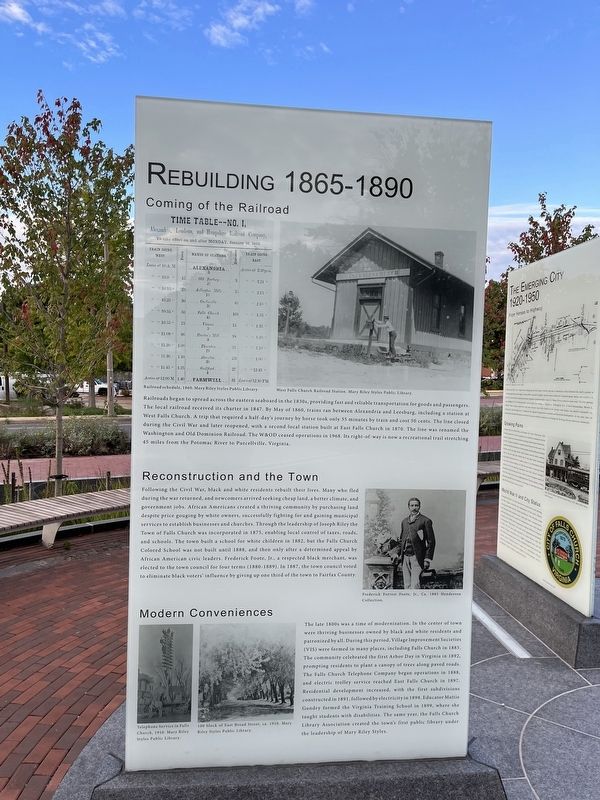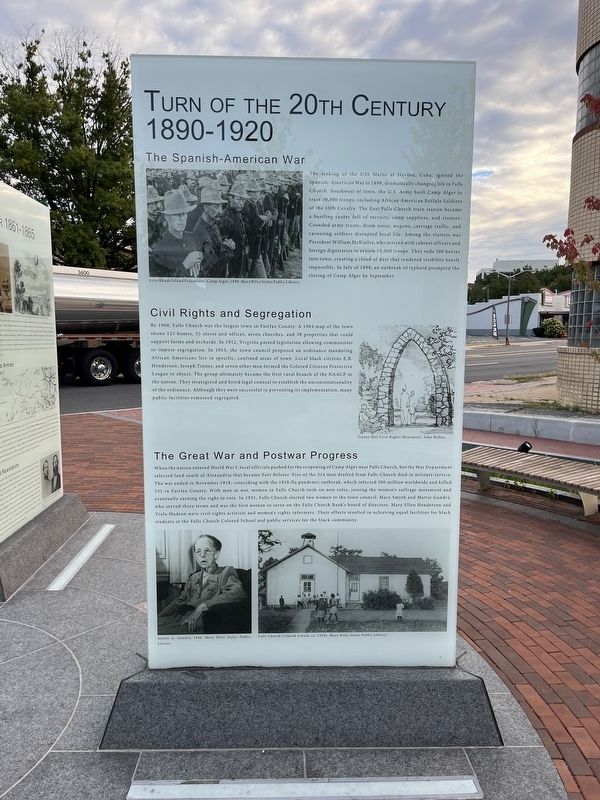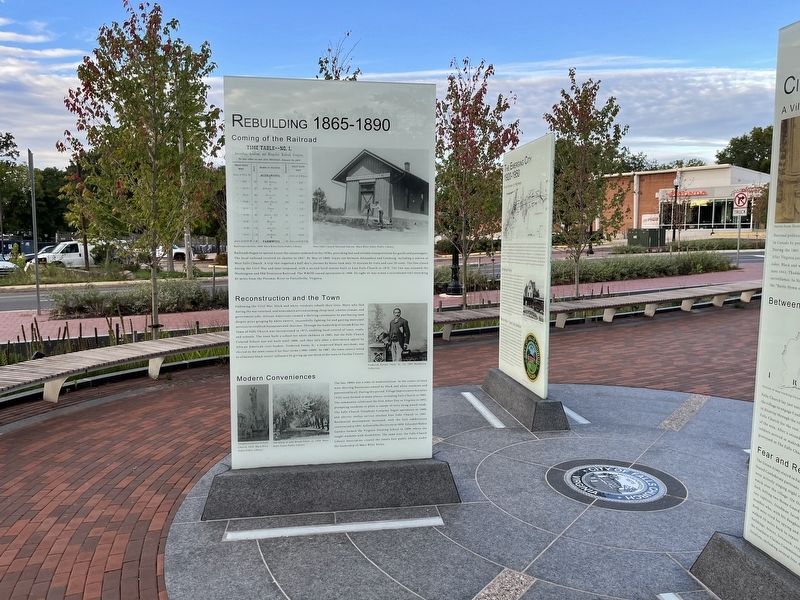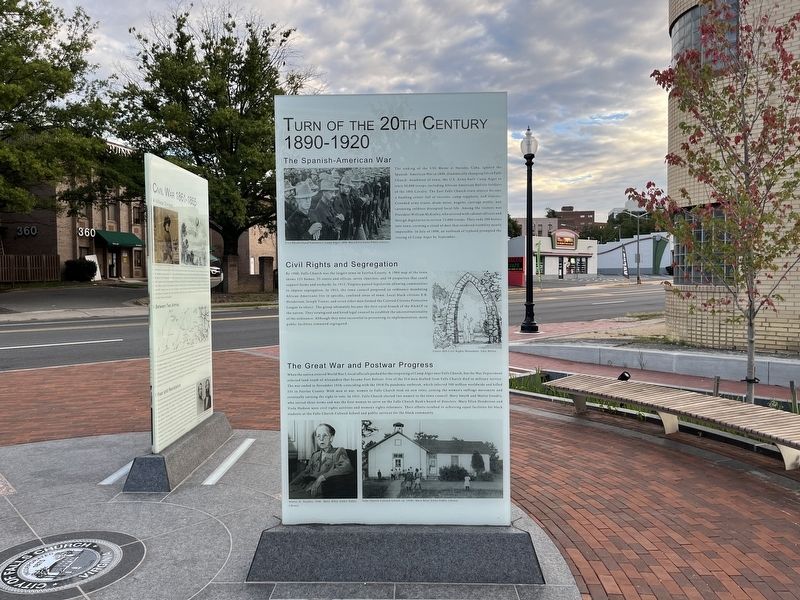Falls Church, Virginia — The American South (Mid-Atlantic)
Rebuilding 1865 - 1890 / Turn of the 20th Century 1890 - 1920

Photographed By Devry Becker Jones (CC0), September 24, 2022
1. Rebuilding 1865 - 1890 side of the marker
Rebuilding 1865 - 1890
Coming of the Railroad
Railroads began to spread across the eastern seaboard in the 1830s, providing fast and reliable transportation for goods and passengers. The local railroad received its charger in 1847. By May of 1860, trains ran between Alexandria and Leesburg, including a station at West Falls Church. A trip that required a half-day's journey by horse took only 35 minutes by train and cost 50 cents. The line closed during the Civil War and later reopened, with a second local station built at East Falls Church in 1870. The line was renamed the Washington and Old Dominion Railroad. The W&OD ceased operations in 1968. Its right-of-way is now a recreational trail stretching 45 miles from the Potomac River to Purcellville, Virginia.
Reconstruction and the Town
Following the Civil War, black and white residents rebuilt their lives. Many who fled during the war returned, and newcomers arrived seeking cheap land, a better climate, and government jobs. African Americans created a thriving community by purchasing land despite price gouging by white owners, successfully fighting for and gaining municipal services to establish businesses and churches. Through the leadership of Joseph Riley the Town of Falls Church was incorporated in 1875, enabling local control of taxes, roads, and schools. The town built a school for white children in 1882, but the Falls Church Colored School was not built until 1888, and then only after a determined appeal by African American civic leaders. Frederick Foote, Jr., a respected black merchant, was elected to the town council for four terms (1880-1889). In 1887, the town council voted to eliminate black voters' influence by giving up one third of the town to Fairfax County.
Modern Conveniences
The late 1800s was a time of modernization. In the center of town were thriving businesses owned by black and white residents and patronized by all. During this period, Village Improvement Societies (VIS) were formed in many places, including Falls Church in 1885. The community celebrated the first Arbor Day in Virginia in 1892, prompting residents to plant a canopy of trees along paved roads. The Falls Church Telephone Company began operations in 1888, and electric trolley service reached East Falls Church in 1897. Residential development increased, with the first subdivisions constructed in 1891, followed by electricity in 1898. Educator Mattie Gundry formed the Virginia Training School in 1899, where she taught students with disabilities. The same year, the Falls Church Library Association created the town's first public library under the leadership of Mary Riley Styles.
Turn

Photographed By Devry Becker Jones (CC0), September 24, 2022
2. Turn of the 20th Century 1890 - 1920 side of the marker
1890 - 1920
The Spanish-American War
The sinking of the USS Maine at Havana, Cuba, ignited the Spanish-American War in 1898, dramatically changing life in Falls Church. Southwest of town, the U.S. Army built Camp Alger to train 30,000 troops, including African American Buffalo Soldiers of the 10th Cavalry. The East Falls Church train station became a bustling center full of recruits, camp suppliers, and visitors. Crowded army trains, drum noise, wagons, carriage traffic, and carousing soldiers disrupted local life. Among the visitors was President William McKinley, who arrived with cabinet officers and foreign dignitaries to review 15,000 troops. They rode 200 horses into town, creating a cloud of dust that rendered visibility nearly impossible. In July of 1898, an outbreak of typhoid prompted the closing of Camp Alger by September.
Civil Rights and Segregation
By 1900, Falls Church was the largest town in Fairfax county. A 1904 map of the town shows 125 homes, 55 stores and offices, seven churches, and 38 properties that could support farms and orchards. In 1912, the town council proposed an ordinance mandating African Americans live in specific, confined areas of town. Local black citizens E.B. Henderson, Joseph Tinner, and seven other men formed the Colored Citizens Protective League to object. The group ultimately

Photographed By Devry Becker Jones (CC0), September 24, 2022
3. Rebuilding 1865 - 1890 side of the marker
The Great War and Postwar Progress
When the nation entered World War I, local officials pushed for the reopening of Camp Alger near Falls Church, but the War Department selected land of Alexandria that became Fort Belvoir. Five of the 314 men drafted from Falls Church died in military service. The war ended in November 1918, coinciding with the 1918 flu pandemic outbreak, which infected 500 million worldwide and killed 531 in Fairfax county. With men at war, women in Falls Church took on new roles, joining the women's suffrage movement and eventually earning the right to vote. In 1921, Falls Church elected two women to the town council. Mary Smyth and Mattie Gundry, who served three terms and was the first woman to serve on the Falls Church Bank's board of directors. Mary Ellen Henderson and Viola Hudson were civil rights activists and women's rights reformers. Their efforts resulted in achieving equal facilities for black students at the Falls Church Colored School and public services for the black community.
Erected 2022 by City of Falls Church, Virginia

Photographed By Devry Becker Jones (CC0), September 24, 2022
4. Turn of the 20th Century 1890 - 1920 side of the marker
Topics and series. This historical marker is listed in these topic lists: African Americans • Civil Rights • Communications • Railroads & Streetcars. In addition, it is included in the Former U.S. Presidents: #25 William McKinley, and the Washington and Old Dominion (W&OD) Railroad series lists. A significant historical month for this entry is May 1860.
Location. 38° 52.8′ N, 77° 10.471′ W. Marker is in Falls Church, Virginia. Marker is at the intersection of South Washington Street (U.S. 29) and Hillwood Avenue (Virginia Route 338), on the right when traveling north on South Washington Street. Touch for map. Marker is at or near this postal address: 336 S Washington St, Falls Church VA 22046, United States of America. Touch for directions.
Other nearby markers. At least 8 other markers are within walking distance of this marker. The Emerging City 1920 - 1950 / 1950 and Beyond (here, next to this marker); Virginia Village 1815 - 1861 / Civil War 1861 - 1865 (here, next to this marker); The Story of Falls Church / Settlement 1700 - 1815 (here, next to this marker); Home of Mary Ellen Meriwether (Miss Nellie) and Dr. Edwin B. Henderson (EB) (about 400 feet away, measured in a direct line); Sears Kit Home (about 400 feet away); Colored Citizens Protective League (about 400 feet away); Plans to Fight the Ordinance (about 400 feet away); Dr. Edwin Bancroft Henderson (1883-1977) (about 400 feet away). Touch for a list and map of all markers in Falls Church.
Additional keywords. segregation; Jim Crow era
Credits. This page was last revised on May 29, 2023. It was originally submitted on September 24, 2022, by Devry Becker Jones of Washington, District of Columbia. This page has been viewed 109 times since then and 19 times this year. Photos: 1, 2, 3, 4. submitted on September 24, 2022, by Devry Becker Jones of Washington, District of Columbia.